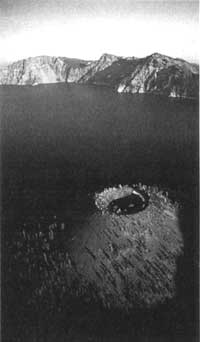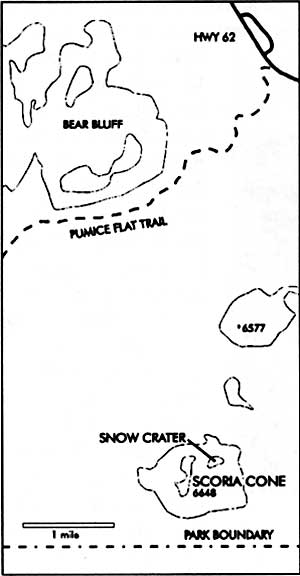|
Volume XXVI - 1995
Ancient Remnants in Snow Crater
By Steve Mark and Ron Mastrogiuseppe
Craters are geological features usually associated with composite
volcanoes and the top of cinder cones. Found throughout the park, they
are generally less than a kilometer (5/8 mile) across and formed when
volcanic material is ejected through a vent of an active volcano.
Calderas, by contrast, represent volcanism far beyond the activity that
is typical of eruptions associated with craters. To put this in
perspective, the four to six mile-wide depression filled by Crater Lake
is a caldera while the crater on Wizard Island's summit is only a couple
of hundred yards across.

Wizard Island has a crater; Crater Lake is inside a
caldera.
|
That crater on Wizard Island formed after Mount Mazama's climactic
eruption, so it is clearly discernible. Cinder cones such as Crater
Peak, Maklaks Crater, Red Cone, and a number of unnamed points on the
park map have craters obscured by erosion, pumice and ash because they
appeared prior to the cataclysmic event of roughly 7,700 years ago.
Although not abundant, the park contains several post-Mazama craters
in addition to the one on top of Wizard Island. One easily reached by a
short walk from the west rim drive near Hillman Peak is Williams Crater,
sometimes called Forgotten Crater on older maps. Another one is located
some distance from any road, near the park's south boundary. Scoria Cone
is quite unlike the other two, in that it has an exposed crater-like
depression or what some geologists have described as a pit crater.
Most, if not all, of Scoria Cone resulted from a north-south fissure
through which lava extruded 25,000 to 45,000 years ago. It is one of
three prominent cinder cones built on well-rounded lava flows whose
appearance show evidence of glaciation, much like those in the vicinity
of nearby Union Peak. Like many other cinder cones, Scoria Cone has a
crater filled with pumice and ash. There is, however, a deep rectangular
depression or pit on the north end of the older crater floor. Measuring
roughly a hundred yards long and 50 yards across, the pit has
precipitous walls dropping away some 130 feet to the top of a snow and
ice plug.
In the 1940s one park naturalist noticed that snow in this plug is
permanent, even when summer melting in other parts of the park has long
dispatched any sign of winter. He named it Snow Crater, not knowing that
the snow and ice extended 150 feet down a chimney which once provided
the conduit for lava sometime in the past. He could not know because few
people are foolhardy enough to try a descent to the plug, let alone
attempting to go between the conduit's walls and the ice.

Map by Susan Marvin.
Even so, in 1977, after one of the driest years on record, a team of
park rangers explored where no one had ever been previously. They
reached the plug's bottom and found several rooms of various sizes. Two
of the rangers retrieved pieces of wood entombed in ice from near the
bottom of the plug. One of these specimens was subsequently identified
as Douglas-fir, Pseudotsuga menziesii, by a wood technologist at
Washington State University. Its resting place piqued the curiosity of
researchers connected with the park, as no Douglas-fir are known to
occur presently at 6,300 feet anywhere near Crater Lake. Although badly
degraded, the wood showed breakdown in cellular structure that is caused
by hot water or steam. This led to speculation that the fragment might
have been in the pit crater while it was still active.
Although radiocarbon dating of this wood held the prospect of
providing additional insight to mysteries surrounding volcanic activity
at Scoria Cone and the vegetation history of this area, no one could
secure funding for necessary laboratory work for the next 17 years. Only
in 1994 did a sample specimen finally reach a radiocarbon dating lab for
an age determination. After calibration (since radiocarbon years may be
tree ring corrected to reflect calendar years) it was reckoned that this
piece of Douglas-fir is approximately 3,640 years old. The obvious
interpretation of this evidence is that a mixed conifer forest, as seen
today in the park's panhandle (the irregularly-shaped parcel of land
near the south entrance), flourished at Scoria Cone during a period of
warm-dry summer climate roughly 4,000 years before the present. Since
conifers such as Douglas-fir are long-lived, the wood sample may indeed
be one of the last of this species to grow near what became Snow Crater
at Scoria Cone. The nearest forest of similar composition 3,600 years
later is located a few miles downslope, but at 4,500 feet in elevation
near the park's south boundary.
Since three of us felt the need to locate any Douglas-fir presently
living close to Scoria Cone other than those previously mentioned, we
hiked there on August 25, 1994. After 30 minutes on the Pumice Flat
Trail, it took another hour or so by traversing cross country to reach
the top of a cone just north of our destination. We could find no
evidence of Douglas-fir along the way, nor did any appear on the short
jaunt to Scoria Cone. Instead we found a subalpine forest of lodgepole
pine, Pinus contorta v. murrayana, western white pine, Pinus
monticola, true fir (white fir, Abies concolor, and red or
noble fir, A. magnifica-procera), and mountain hemlock, Tsuga
mertensiana.
Once we reached Snow Crater, it did not take long to realize why the
rangers of 17 years earlier felt justified in closing this vent to any
future explorations. Remnants of wooden park signs to this effect could
still be seen as we walked around the pit's perimeter. It was then that
our attention became riveted to a curious three-needled pine clinging to
the precipitous north wall some 200 feet above the plug of snow and ice.
Just why it is there constitutes an interesting question. Surprisingly
enough, what has been called Ponderosa pine, Pinus ponderosa, in
lower elevation mixed conifer habitats can be found today in small
subalpine habitats near Crater Lake's caldera rim, and on warmer
southwest slopes of cinder cones within and near the park. In addition
to the possibility of this three-needled pine being ponderosa, there are
at least two others. These include Jeffrey pine, Pinus jeffreyi,
whose northern distribution is on serpentine substrates near the
Illinois Valley over 100 miles southwest of Crater Lake, and Washoe
Pine, Pinus washoensis, a rare and almost unknown species found
in the mountains bordering the Great Basin.
Trees can often serve as thermometers with sensitivity to
temperature changes induced by fluctuations in climate. Cold abbreviates
the length of growing seasons, thereby limiting critical processes such
as photosynthesis. The result is a narrow growth ring and long periods
without viable seed production. Even cold-hardy ponderosa pines would
find survival in the short growing seasons and frequent deep snowpacks
of subalpine habitats difficult.
The mixed conifer forest (with Douglas-fir as an associate) seen
today within the neighborhood of the park's panhandle has not always
been situated there. At the time of Mt. Mazama's great eruption, 7,700
years ago, a climatic interval known as the Altithermal or Hypsithermal
Period was underway. It began some 8,000 years ago and persisted for
approximately four millennia. Marked by significantly warmer and dryer
summers than at present, this time featured climatic changes which
altered growing conditions which favored the upslope migration of the
mixed conifer forest. Associated advances and retreats of forest
community borders along elevational gradients are well documented
throughout western North America.
Changes in vegetation zone elevations are affected by shifts in
critical growing season temperature and moisture regimes. A shift to
cooler, more moist conditions following the Altithermal Period spurred a
retreat of the mixed conifer forest to lower elevation habitats over the
past few thousand years. Isolated and disjunct stands of three-needled
pines within the subalpine zone today represent local pine variants. As
relicts of past environments, they may link prehistoric forest
assemblages to our time and place. The sentinel pine grasping the
volcanic rock for moisture and nutrients above Snow Crater may hold one
key for gaining a better understanding of the linkage between past and
present. Our visit to Scoria Cone provided an opportunity to interpret
the present scene and wonder about the relationships resulting from
those geologic, climatic, and biological forces present during the era
when a 12,000 foot Mount Mazama dominated the landscape.
Steve Mark is the park historian at Crater Lake. He has been
editor of Nature Notes since its revival in 1992.
Ron Mastrogiuseppe is a former seasonal employee at Crater Lake.
He is now based in Burns, Oregon, where he is an ecologist.

Panorama of Mt. Mazama from the southwest, sketched
by Howel Williams.
Howel Williams, The Geology of Crater Lake
National Park, Oregon, Washington, DC: Carnegie Institution of
Washington, 1942, p. 66.
|

